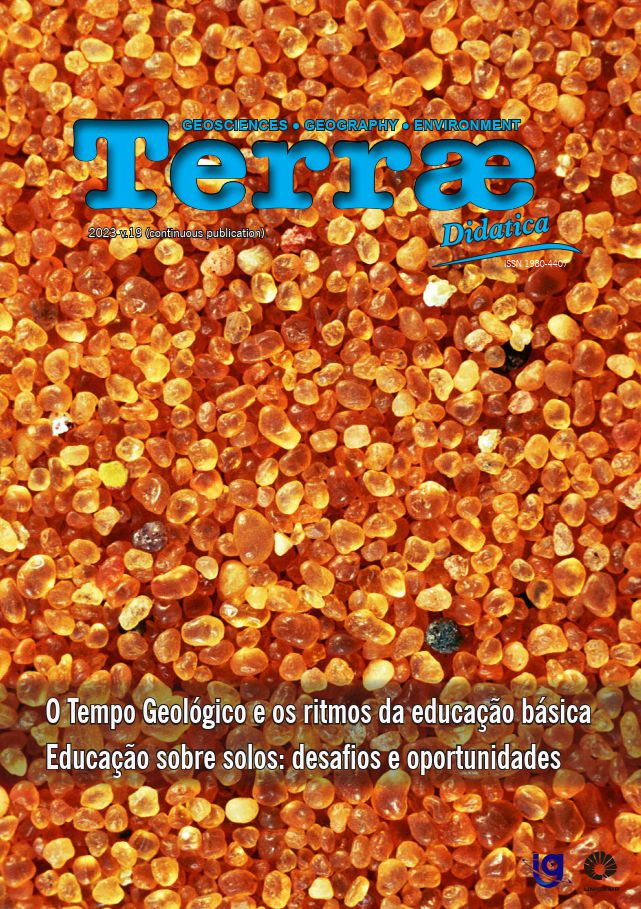Abstract
Introduction. This article proposes a reflection about Geology teaching in basic education, using a seminal contribution of the author Conrado Paschoale: “Alice in the Geology land and what she found there”. Objective. The objective is to center a reflection on the training of a teacher who never could learn Geology by “doing it” but is obliged to develop related contents in classrooms. Methodology Starting from the “Alice” proposal, we find a professor entering the world of Geology, but finds nothing, because he/she lacks geoscientific knowledge to understand and, therefore, to teach, too. Results. Poor teacher training generates cascading problems, especially at a time when new discoveries in Geosciences demand rapid teacher updating. Faced with simplistic representations and models, the teacher needs to develop a high level of conceptual abstraction – such as the conception of Geological Time, among many others – in order to understand how the planet Earth works. Conclusion. Aggregating new knowledge and relating it to previous knowledge seems to be a satisfactory way for interrupting a vicious circle in which the poor quality of teaching is due to poor teacher training.
References
Carneiro, C. D. R., Pereira, S. Y., Ricardi-Branco, F. S. T., & Gonçalves, P. W. (2022). Roteiros de difusão das Geociências sob nova visão da sociedade pós-pandemia (Apresentação). Terræ Didatica, 18(Publ. Contínua). e021001. doi: 10.20396/td.v18i00.8668004.
Figueirôa, S. F. M. (2009). História e Filosofia das Geociências: relevância para o ensino e formação profissional. Terræ Didatica, 5(1), 63-71. doi: 10.20396/td.v5i1.8637503.
Gil-Perez, D., Sifredo, C., Valdéz, P., & Vilches, A. (2005). ¿Cual es la importancia de la Educación Científica en la sociedad actual? In: Como promover el interés por la cultura científica: Una propuesta didáctica para la educación científica de jóvenes de 15 a 18 años. Santiago, Orealc/UNESCO,
Lewenstein, B. V. (2003). Models of Public Communication of Science & Technology. eCommons. Open scholarship at Cornell. Version: 16.June.2003. URL: https://hdl.handle.net/1813/58743. Acesso 17.02.2023.
Parker, R., Thomsen, B. S., & Berry, A. (2022). Learning through play at school. A framework for policy and practice. Front. Educ., 7, 751801. doi: 10.3389/feduc.2022.751801.
Paschoale, C. (1984). Alice no País da Geologia e o que ela encontrou lá. In: Congresso Brasileiro de Geologia, 33, Rio de Janeiro, 1984. Anais..., Rio de Janeiro: SBG. v. XI, p. 5.242-5.249.
Serviço Geológico do Brasil. SGB/CPRM. (2022). SGB Educa. Brasília: SGB/CPRM. URL: https://sgbeduca.cprm.gov.br/jovens_geociencias_geocoisas.html, Acesso 20.12.2022.
Vasconcelos, C., & Orion, N. (2021). Earth Science Education as a Key Component of Education for Sustainability. Sustainability. 13(3):1316. doi: 10.3390/su13031316.

This work is licensed under a Creative Commons Attribution 4.0 International License.
Copyright (c) 2023 Rosely Aparecida Liguori Imbernon, Clara Vasconcelos, Katia Leite Mansur, Pedro Wagner Gonçalves, Celso Dal Ré Carneiro


